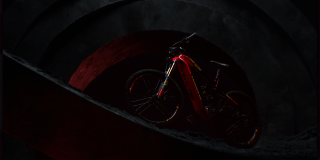Haibike FlyOn – Next Generation ePerformance
Since the German manufacturer Haibike introduced its models to the 2019 generation, the e-bike world has not been the same. The design of the Haibike e-mountainbikes has always been something special. But with the introduction of the new TQ engine, the innovation factor could be topped again. The distinctive feature of the drive is its round shape. At Haibike, the TQ motor is installed under the name FlyOn in the top models of the Haibike E-MTBs.
TQ und Haibike FlyOn – the philosophy
The TQ engine is a real alternative to the popular engines from Bosch, Shimano and Yamaha. And with the FlyOn models, Haibike is not only expanding its position as an e-bike pioneer and trailblazer, but the Schweinfurt manufacturer is also increasingly strengthening its own identity.
Not only that the futuristic look of the engine attracts all eyes. It is also the technical data that causes an unbelieving shake of the head. Above all, the maximum torque of the TQ engine of 120 Nm sounds like a real surprise compared to Bosch and Co. (about 75 Nm) almost unbelievable. What exactly this figure means, and whether you need that much power at all, is explained further down in the technology chapter.
Haibike and TQ-Systems worked very closely together in the development of the new FlyOn models. The goal was a perfect integration of the drive. This includes the motor, the battery and the display. The name FlyOn therefore refers to the complete system, not just the TQ motor alone.
Innovative pin ring gear – the technology
Behind the sober factory designation TQ HPR 120S, forward-looking technology is hidden. The round shape of the motor results from its mode of operation. Because inside, a so-called pin-ring transmission rotates in conjunction with an electric motor. Simply explained: The power of the motor is transmitted to the crank via an elliptical bearing with a toothed inner and outer ring. The different size of the two toothed rings results in a single, fixed transmission ratio. This is 1:37 for the TQ engine, and this is one of the decisive differences to a conventional mid-mounted engine: The TQ engine does not require a multi-stage transmission.
Another difference: The pin-ring gear rotates around the bottom bracket, which allows a very compact design of the motor. Why Pinring? Because the connection between gear/motor and chainring is made via pins. This results in a very high degree of efficiency and thus also the high and above all constant torque.
Unbridled power – but dosable!
What effect does the high torque have during driving? Anyone who has experience with e-mountainbikes knows this scenario: a steep and long climb. In order to get the optimum power out of the engine, you have to find the right gear, the right ratio – just like on a normal bike without an engine. The TQ engine reacts less sensitively to this. It constantly delivers high power, even in relatively high gears. You can shift gears, but you don’t have to.
With all the torque that the TQ engine delivers, its power can still be sensitively dosed. This is ensured by a highly sensitive sensor that permanently records the driver’s pedal pressure. Because without a fine response, the rear wheel would immediately spin when starting uphill.
Another feature of the TQ engine is its integrated freewheel. This means that when the drive is switched off or when the 25 km/h assistance limit is exceeded, a Haibike FlyOn e-mountain bike can be pedaled without resistance. There are no internal components of the motor running. And you hardly have to worry about the range. The Haibike FlyOn models are equipped with durable 630 watt hour batteries.https://www.youtube-nocookie.com/embed/kx-WZKpsrUU




